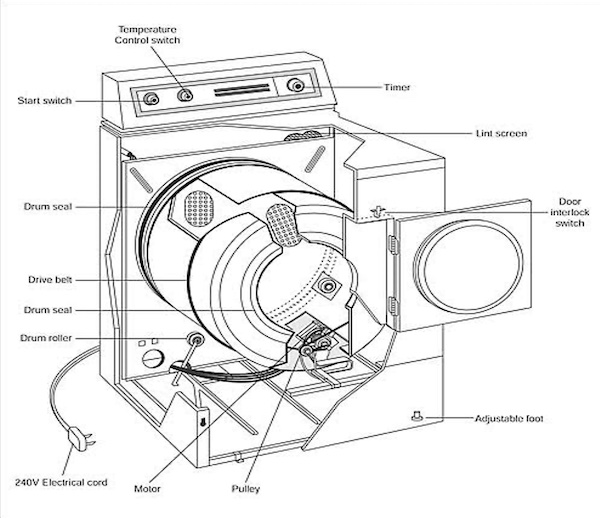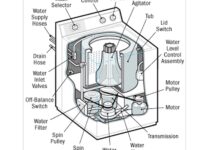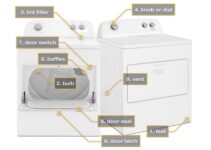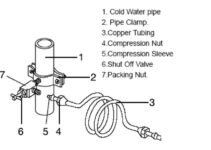As a homeowner, you’ve probably experienced the frustration of being unable to find an appliance that fits into your space. You can make do with a single washer-dryer or buy two separate ones.
But if you’re short of space and willing to sacrifice a little extra cash, the Kenmore Stackable Washer-Dryer could be just what you need to have both machines in one unit.
Here, however, we’d be looking at the parts and components of the Kenmore Stackable Washer-Dryer. We’d also go into details of each part and its functions.
Kenmore Stackable Washer-Dryer Parts Diagram


Kenmore Stackable Washer-Dryer Parts and Their Functions
To understand how a stackable washer-dryer works, you’ll need to know the basic parts of a stackable. These include;
Load Door
The loading door is a plastic piece that opens to allow you to load your laundry. It has a latch that locks it closed, and there’s also a rubber seal around the edges of the door to keep water from leaking out.
The second part of this unit is where you put your clothes, and it’s called a deck plate or washer drum (depending on which brand you have). This piece holds everything together so that when it spins at high speed during cleaning cycles, everything stays secure in place during washing or drying cycles.
Load Door Seal
The load door seal is a rubber piece that fits around the door and forms a seal to keep water and air inside the washer when it is being used.
If the seal is worn down, it can let water and air escape. This will result in a leaky washer that uses more energy than it should. The seal can also wear down due to age, so if you have an older model, this may be a more common issue.
Drum
The drum is the washing machine’s main compartment. It contains water, and it spins during the wash cycle to agitate clothes, which helps them properly clean themselves.
The drum is removable for easy cleaning, but you should avoid using harsh chemicals or abrasive sponges on it because they could damage its finish.
The washing machine drum is made of molded plastic or stainless steel. It’s round and has a drain on the bottom to let water out when you’re done with a load. The spin cycle uses centrifugal force to push water out of the drum, which helps prevent mildew.
Agitator Arms
Agitator Arms are used to mix the clothes in the wash. They are attached to the drum, and they rotate while agitating your laundry.
The agitator’s arms are also known as spinners or paddles, which may have different names depending on your brand. In general, an agitator arm spins around at high speed and rotates underneath a drum full of water so that it can mix up all of your clothes without leaving any lumps or clumps behind when washing them!
Blower Wheel
The blower wheel is located in the front of your machine, and it’s what blows air into the dryer. It’s made of plastic, rubber, and metal. The blower assembly connects to both sides of your washer-dryer unit so that it can be turned on or off independently.
If the blower wheel is broken, it can cause your machine to overheat and shut down. If it’s not working properly, it may cause lint to be blown around inside the dryer rather than out into the exhaust vent. This can lead to several issues, including fire hazards.
Pump and Motor Assembly
The pump and motor assembly are a little more complicated than most other parts, but it’s still pretty straightforward. The pump raises and lowers the water in your machine while the motor spins it so you can wash clothes as quickly as possible. This part also ensures that water doesn’t spill over when you open up your washer-dryer—a common problem with stacked units like this one.
The benefits of having this part are obvious: It helps keep everything working smoothly by ensuring that there isn’t any excess or excessive pressure in any area of your washer/dryer set-up, which is especially important when dealing with stacked units like these!
Timer Knob
The timer knob is located on the front of your washer-dryer. It controls when you want to wash and dry clothes and how long it takes for each cycle to complete.
Start Switch
The start switch is a safety device that prevents the washer or dryer from operating unless the door is closed. It’s located on the front of your Kenmore stackable washer, and it’s usually a red button.
When you press this button, it sends a signal to your washer/dryer that you’re ready to start washing or drying clothes.
If the door switch is broken or malfunctioning, it won’t send that signal to your machine. That’s why you need to repair or replace it.
If your washer doesn’t start up, you press the door switch, and your switch is likely broken. To test this, unplug the washer and remove any laundry from the tubs. Then place a wooden block against the front of each tub so they can’t move back and forth while you’re testing them.
Plug the washer back in and press the start button. If your machine starts up, then it’s likely that your door switch is broken. You’ll need to repair or replace it.





